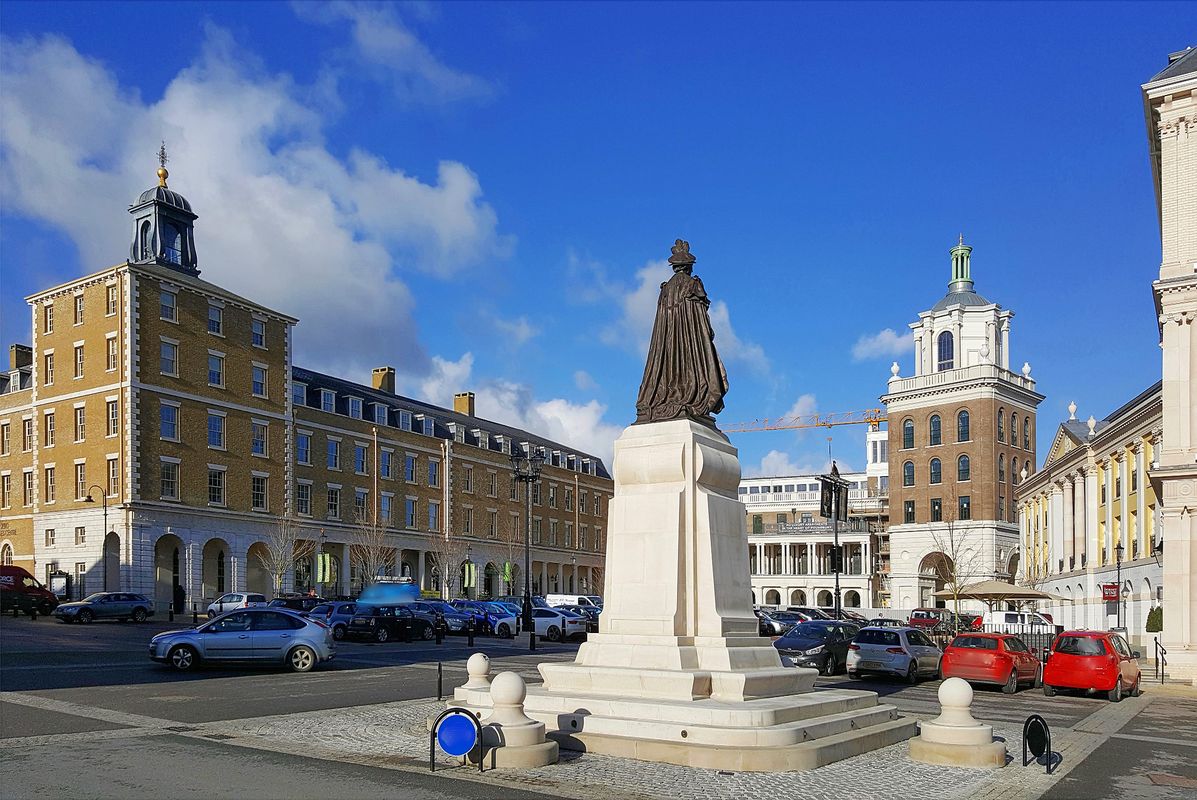It’s almost 40 years since Prince Charles stunned the architecture world with his famous carbuncle speech. It was May 1984 and Charles was delivering the keynote at the Royal Institute of British Architects’ 150th birthday gala at Hampton Court Palace. He could hardly have chosen a more dramatic moment to inveigh against modern architecture. I thought he was right. But was he right to say it?
A gently daffy prince is one thing. But an interventionist king? Suddenly, under Charles III, this question bleeps red for us all.
In 1984, postmodernism was in full swing. A soft rebellion, it strove to enliven modernist austerity with pastel colours, mannerist jokes and historical allusion. Yet a competition to extend William Wilkins’s 1834 stiff neoclassical National Gallery on Trafalgar Square had recently been won by staunch modernists Ahrends Burton Koralek with a scheme that was unashamedly glassy and asymmetrical. Charles, in his signature crystalline drawl, likened it to a pus-filled follicle “on the face of a much-loved and elegant friend.” Furore erupted.
Drawing for ABK’s final revised National Gallery Extension design, 1983.
Image: RIBA Collections
Architects everywhere were divided. On the one hand, it was flattering for this generally ignored profession that a future monarch should care enough about architecture to venture so far past the safe pastures of official blandishment. On the other, how dare he undermine the experts like that? The Institute’s grey and eminent heads shook in dismay. How dare he? But their umbrage was barely the tip of the iceberg.
Six months into my job as assistant editor at The Architectural Review in Westminster, I was tasked with writing up the story. I knew little of the monarchy and cared even less. But I was sympathetic to Charles’s sentiments. The ABK proposal was underwhelming at best. I thought it refreshing to have it said, especially in so stodgy a culture and at so elevated a level.
But (the Britons patiently pointed out) there was more at stake than mere taste or style. This went to the Constitution.
Even now, notwithstanding Australia’s recent paroxysms over Queenly death and Kingly ascension, ours is a constitutional monarchy, not a real one. Our royals are meant to wear the frocks, attend the parties and play nice. That’s it. They are not entitled to intervene in politics. The RIBA speech was unquestionably intervention, and unquestionably politics.
I was fascinated. Until then, it had never struck me that a situation could arise where a person had the power to effect change for good, but that it would nevertheless be wrong for them to do so. This was a dilemma of heroic intensity.
In the end, I inverted Voltaire. Contrary to his apocryphal “I disapprove of what you say, but I will defend to the death your right to say it,” I supported the Prince’s view but could not uphold his right to voice it.
Now Charles is King. In the decades between, he has proved himself thoroughly unrepentant, intervening time and again in schemes, competitions and proposals, including Paternoster Square, London and the Museum of Scotland. He has built Poundbury, a model traditional village on Duchy lands in Dorset, and proposes another “garden village” of 2,500 homes on royal farmland on the outskirts of Faversham in Kent. The Prince’s Foundation sponsors an award for “Emerging Excellence in the Classical Tradition” and has a project on public housing land in inner Sydney’s Glebe.
The NSW Land and Housing Corporation partnered with the Prince’s Trust to create the Glebe Mid-Rise Project designed by Johnson Pilton Walker.
Image: Supplied
Now, as Princely foible morphs into Kingly mandate, the questions are urgent. Is he, as a constitutional monarch, entitled to proselytize in a field that profoundly affects people’s lives? And, quite separately, is what he promotes desirable?
On the question of heritage and tradition, I find myself still, in part, sympathetic. In 1987, during an address at the annual dinner of the Corporation of London’s Planning and Communications Committee, Charles said that architects and developers had damaged Britain’s cities more than the Luftwaffe during World War II. His comment applies to Australian cities today, where our continuing failure to learn from traditional urbanism is sucking the soul from our urban fabric. But I doubt that imitating ancient styles is the way forward.
I’ve visited Poundbury, which I found stiff and soulless – the edges too neat, the roads too wide, the whole too sanitized and homogenous for authenticity. It has no bustle or sense of genuine public life. Similarly, Robert Venturi and Denise Scott-Brown’s substitute National Gallery extension is still, almost 40 years on, a feeble thing, its spoof columns as unconvincing as a bad joke after too many tellings. Yet it is less obtrusive in the square than ABK’s glass tower (which was eventually refused planning permission) would have been.
Queen Mother Square in Poundbury, Dorset by Léon Krier, licensed under Creative Commons Attribution-Share Alike 4.0 International license.
Image: Léon Krier
So, how to proceed?
In any sphere, from religion to psychology to architecture, the tradition question is critical: which parts to keep and which to jettison? Modernism showed that, as Mies famously admonished, the urge to “invent a new architecture every Monday morning” destroys more than it creates. Nevertheless, change is essential and lifegiving, so any tradition, sustained holus-bolus, becomes stultifying and oppressive.
Just before Christmas 2020, Donald Trump signed into law a Presidential edict entitled “Promoting Beautiful Federal Civic Architecture.” Although softer than its original proposal (and since overturned by Biden), the edict made “classical architecture … the preferred and default architecture for Federal public buildings” throughout Washington, DC.
Its rationale was seductive. Citing Alberti and Brunelleschi, Palladio and Wren, Jefferson and L’Enfant, the document argued that “public buildings should uplift and beautify public spaces, inspire the human spirit, ennoble the United States, and command respect from the general public.”
But the issues here are moral as well as visual. Aesthetic freedom is a fundamental principle of democracy. Trump’s elegant phrasing cannot conceal a chilling parallel with Hitler’s ban on modern art and architecture for similar reasons of national dignity. New Urbanist towns and villages such as Seaside, Florida, have long been criticized for their white-bread feel and white-collar exclusivity. We must also expect that, without a similar cultural drive and constructional exigency – what, are we proposing to build in structural marble? – the buildings produced by such an edict will feel as sanitized and soulless as Poundbury’s faux-Georgian.
To my mind, the answer must lie in recognizing that the opposing needs for both change and continuity constitute an urgent design challenge. Rather than replicating the classical style, our civic buildings should instead emulate that tradition’s respect for materials, grasp of proportion, flexibility of use, judicious decoration, intricacy of detail and acknowledgement of the street as our principle public realm.
This is why a movement like Street Level Australia holds such promise. Established by young, Perth-based non-architect Milly Main, Street Level has chapters in most Australian cities and regards itself as “building a revolution to increase the number of beautiful, quality and enduring local neighbourhoods, streets and buildings in Australia.” Its current Sydney Is Beautiful competition*, focused on a vacant block in Woolloomooloo, hopes to inspire “a new generation of architects to embrace the timeless principles of new traditional architecture and urbanism.”
I’m still unpersuaded that Charles III should be given sway on this stuff (beyond an allowable predilection), or indeed that his taste is up to the task. But I am greatly buoyed by the idea that we ordinary types might rise up and demand our rightful voice in city-making. After all, they’re our towns, our neighbourhoods. Our streets.
* Elizabeth Farrelly has agreed to be a judge in Street Level’s Sydney Is Beautiful competition.























